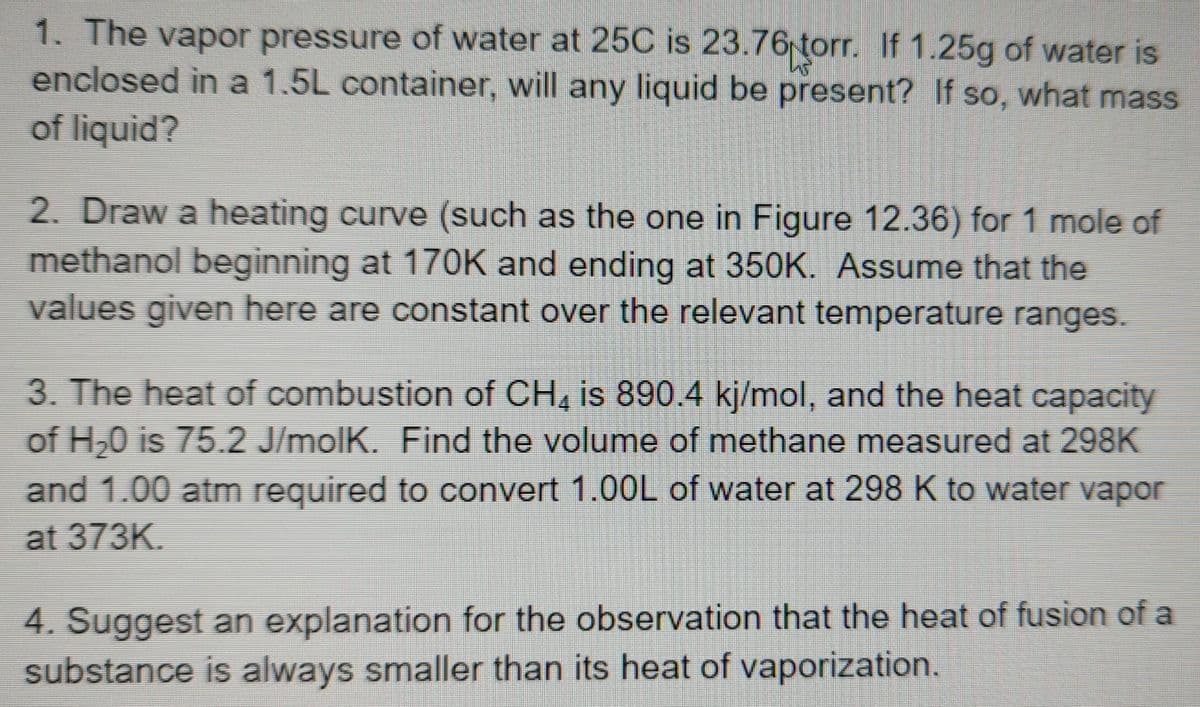1. The vapor pressure of water at 25C is 23.76 torr. If 1.25g of water is enclosed in a 1.5L container, will any liquid be present? If so, what mass of liquid?
1. The vapor pressure of water at 25C is 23.76 torr. If 1.25g of water is enclosed in a 1.5L container, will any liquid be present? If so, what mass of liquid?
Chemistry for Engineering Students
4th Edition
ISBN:9781337398909
Author:Lawrence S. Brown, Tom Holme
Publisher:Lawrence S. Brown, Tom Holme
Chapter8: Molecules And Materials
Section: Chapter Questions
Problem 8.87PAE: 8.87 Use the vapor pressure curves illustrated here to answer the questions that follow. (a) What is...
Related questions
Question
A3

Transcribed Image Text:1. The vapor pressure of water at 25C is 23.76 torr. If 1.25g of water is
enclosed in a 1.5L container, will any liquid be present? If so, what mass
of liquid?
2. Draw a heating curve (such as the one in Figure 12.36) for 1 mole of
methanol beginning at 170K and ending at 350K. Assume that the
values given here are constant over the relevant temperature ranges.
3. The heat of combustion of CH4 is 890.4 kj/mol, and the heat capacity
of H₂0 is 75.2 J/molK. Find the volume of methane measured at 298K
and 1.00 atm required to convert 1.00L of water at 298 K to water vapor
at 373K.
4. Suggest an explanation for the observation that the heat of fusion of a
substance is always smaller than its heat of vaporization.
Expert Solution
This question has been solved!
Explore an expertly crafted, step-by-step solution for a thorough understanding of key concepts.
This is a popular solution!
Trending now
This is a popular solution!
Step by step
Solved in 3 steps with 2 images

Knowledge Booster
Learn more about
Need a deep-dive on the concept behind this application? Look no further. Learn more about this topic, chemistry and related others by exploring similar questions and additional content below.Recommended textbooks for you

Chemistry for Engineering Students
Chemistry
ISBN:
9781337398909
Author:
Lawrence S. Brown, Tom Holme
Publisher:
Cengage Learning

Chemistry: Principles and Practice
Chemistry
ISBN:
9780534420123
Author:
Daniel L. Reger, Scott R. Goode, David W. Ball, Edward Mercer
Publisher:
Cengage Learning

Chemistry & Chemical Reactivity
Chemistry
ISBN:
9781337399074
Author:
John C. Kotz, Paul M. Treichel, John Townsend, David Treichel
Publisher:
Cengage Learning

Chemistry for Engineering Students
Chemistry
ISBN:
9781337398909
Author:
Lawrence S. Brown, Tom Holme
Publisher:
Cengage Learning

Chemistry: Principles and Practice
Chemistry
ISBN:
9780534420123
Author:
Daniel L. Reger, Scott R. Goode, David W. Ball, Edward Mercer
Publisher:
Cengage Learning

Chemistry & Chemical Reactivity
Chemistry
ISBN:
9781337399074
Author:
John C. Kotz, Paul M. Treichel, John Townsend, David Treichel
Publisher:
Cengage Learning

Chemistry & Chemical Reactivity
Chemistry
ISBN:
9781133949640
Author:
John C. Kotz, Paul M. Treichel, John Townsend, David Treichel
Publisher:
Cengage Learning

Introductory Chemistry: A Foundation
Chemistry
ISBN:
9781337399425
Author:
Steven S. Zumdahl, Donald J. DeCoste
Publisher:
Cengage Learning

Chemistry: An Atoms First Approach
Chemistry
ISBN:
9781305079243
Author:
Steven S. Zumdahl, Susan A. Zumdahl
Publisher:
Cengage Learning